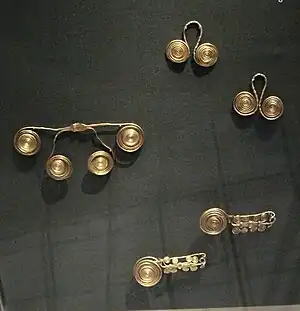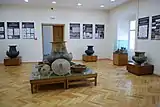Gáva-Holigrady culture
The Gáva-Holigrady culture was a late Bronze Age culture of Eastern Slovakia, Western Ukraine (Zakarpats'ka Oblast and Dnister river basin), Northwestern Romania, Moldova, and Northeastern Hungary.
| Geographical range | Hungary, Slovakia, Romania, Moldova, Ukraine |
|---|---|
| Period | Bronze Age, Iron Age |
| Dates | 13th century - 9th century BC |
| Preceded by | Vatya culture, Noua-Sabatinovka culture |
| Followed by | Hallstatt culture, Thracians, Thraco-Cimmerians |


It is considered a subtype of the Urnfield culture.
Gava-Holigrady culture is named after an archaeological settlement Gava in Northeastern Hungary and an archaeological site Holigrady (Голігради) in Ukrainian Ternopil Oblast.
In Slovakia, the culture originated in the early 12th century BC.
Gáva people lived in settlements and hillforts that they built in the Slovakian and Transylvanian uplands.
Gava-Holigrad people are considered to be of Thracian ethnicity.
Gallery
 Gold vessel from Biia, Romania, 12th century BC
Gold vessel from Biia, Romania, 12th century BC Ceramic vessel from the Teleac hillfort, Romania
Ceramic vessel from the Teleac hillfort, Romania Bronze helmet and sword from Romania
Bronze helmet and sword from Romania Hinova treasure, Romania,12th century BC
Hinova treasure, Romania,12th century BC Hinova treasure, Romania,12th century BC
Hinova treasure, Romania,12th century BC Gold diadem, Hinova treasure
Gold diadem, Hinova treasure
Lăpuş Group
The Lăpuş Group is considered to be a Romanian counterpart of the Gáva-Holigrady culture.[2]

 Lăpuş Group pottery, 13th century BC.[3]
Lăpuş Group pottery, 13th century BC.[3]
 Sarasau hoard gold, Romania, 1300-1200 BC
Sarasau hoard gold, Romania, 1300-1200 BC.jpg.webp) Sarasau hoard 1300-1200 BC
Sarasau hoard 1300-1200 BC
References
- Hansen, Svend (2019). "The Hillfort of Teleac and Early Iron in Southern Europe". In Hansen, Svend; Krause, Rüdiger (eds.). Bronze Age Fortresses in Europe. Verlag Dr. Rudolf Habelt GmbH, Bonn. p. 205.
- Boardman, John, ed. (1983). The Cambridge Ancient History, Volume III (PDF). Cambridge University Press. p. 63. ISBN 0521224969.
The Lăpuş group of Crisana-Maramures, which is the Romanian counterpart of the Gava (Hungary) and Holihrady (Slovakia) cultures
- Metzner-Nebelsick, Carola (2012). "Channelled pottery in Transylvania and beyond – ritual and chronological aspects". In ASTALOŞ, Ciprian (ed.). THE GÁVA CULTURE IN THE TISA PLAIN AND TRANSYLVANIA. EDITURA MUZEULUI SĂTMĂREAN. pp. 65–81.